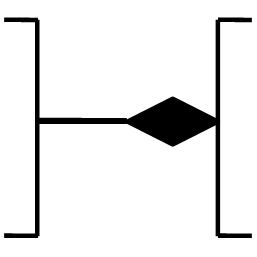The composition relationship indicates that an element consists of one or more other elements.
Template Type: Connectors
Complex Relation
A ComplexRelation is used to show e special relation between DataRelations connected to the same DataEntity. If for example a DataEntity can have relation to one of three other DataEntities, DataRelations are drawn to all three DataEntities. In addition to that a ComplexRelation is created and placed on the diagram.
The DataRelation covered by the ComplexRelation is referenced from a link list in the ComplexRelation. It is also recommended to draw the ComplexRelation on the diagram.
Currently there is no automatic synchronization between the two tasks.
Browser Relation
Relation connection on a BrowserDiagram.
Association DMN
Association in DMN (Decision Model and Notation) refers to the relationship between different elements of a decision model, where one element is associated or linked to another element. Association can be used to represent various types of relationships, such as dependency, influence, or dependency.
For example, in a decision model where a decision is dependent on certain data inputs, the association might be illustrated through a line connecting the decision to the data input. The line would represent the association between the decision and the data input, since the decision is dependent on the input.
Association
A relationship between two classes.
In the Unified Modeling Language (UML), there are five different types of relationships: association, aggregation, composition, dependency, and inheritance.
Association is a semantically weak relationship (a semantic dependency) between otherwise unrelated objects. An association is a ‘using’ relationship between two or more objects in which the objects have their own lifetime and there is no owner.
As an example, imagine the relationship between a doctor and a patient. A doctor can be associated with multiple patients. At the same time, one patient can visit multiple doctors for treatment or consultation. Each of these objects has its own life cycle and there is no ‘owner’ or parent. The objects that are part of the association relationship can be created and destroyed independently.
In UML an association relationship can be represented as one-to-one, one-to-many, or many-to-many (also known as cardinality).
Activity Path
An activity path is a type of connection that is used in diagrams to represent the flow of activities or tasks in a process or project. It typically shows the sequence of steps or tasks required to complete a specific goal or objective. The path may also indicate dependencies, constraints, and milestones between different activities or tasks.
Transition
A connection showing that the object can go from one state to another.
Triggering : ArchiMate
The triggering relationship is used to model the temporal or causal precedence of behavior elements in a process. The usual interpretation of a triggering relationship is that the source element should be completed before the target element can start, although weaker interpretations are also permitted. Note that this does not necessarily represent that one behavior element actively starts another; a traffic light turning green also triggers the cars to go through the intersection.





